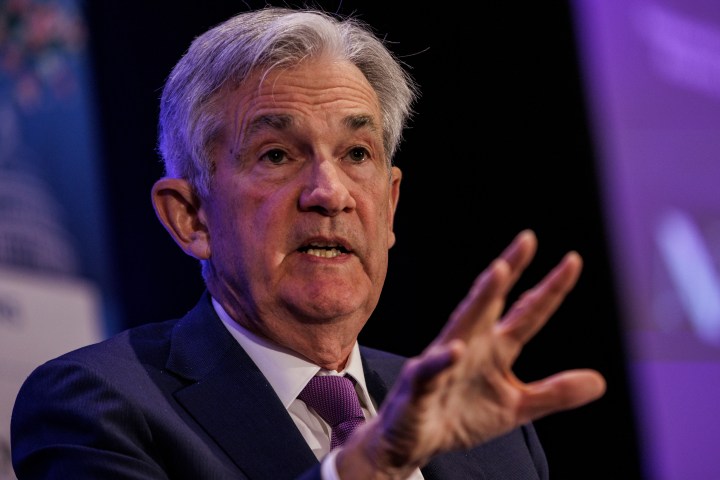
What does it mean when the Federal Reserve uses its “tools”?
What does it mean when the Federal Reserve uses its “tools”?

The central banking system of the United States, the Federal Reserve, has specific jobs to do: keep prices stable and promote full employment. Many know these responsibilities as the Fed’s dual mandate.
The Fed uses a variety of measures to conduct monetary policy and meet certain goals. Often, we hear the chair of the Federal Reserve, Jerome Powell, refer to these measures as tools.
What are these tools, and how do they work?
“Broadly speaking, they all refer in some way or another to making it easier, which is to say less costly, for banks to borrow, or harder, which is to say more costly, for them to do business,” said Nina Eichacker, assistant professor of economics at the University of Rhode Island.
“Marketplace” host Kai Ryssdal spoke with Eichacker about how the tools in the Fed’s toolkit work on inflation and employment. The following is an edited transcript of the interview.
Kai Ryssdal: So, these tools of which Jay Powell speaks — layman’s terms, what are they?
Nina Eichacker: Broadly speaking, they all refer in some way or another to making it easier, which is to say less costly, for banks to borrow or harder, which is to say more costly, for them to do business. So, when the Fed engages in expansionary actions, it uses one of any number of programs to directly or indirectly decrease rates. And if it wants to slow activity, it uses any number of measures to make interest rates higher. With the understanding that higher rates likely curb borrowing, which likely curbs economic activity, which can slow price increases.
Ryssdal: Terrific. Continue with the, with the layman’s terms mantra here, and you said, any one of a number of methods, right? So, the ultimate tool is interest rates. Behind the scenes, what kind of dials and levers are Jay and the gang at the Fed pulling and pushing?
Eichacker: Broadly speaking, the Federal Reserve can purchase bonds and other financial assets that private creditors or private investors may hold. So the classic example from a [macroeconomics] class is the Federal Reserve decides to buy $200,000 worth of U.S. government bonds. By purchasing that bond, the Fed effectively is putting $200,000 into circulation.
Ryssdal: The Federal Reserve, as you and I and regular listeners to this program know, has what’s called a dual mandate, right? Stable prices and maximum employment. The Fed, by using all of the tools of which Mr. Powell and others are so fond of speaking, they can’t actually directly affect either one of those two things, can they, right? They have to use their tools and then wait and see what happens.
Eichacker: That’s correct. All of this activity relies on the other institution at the end of the transaction. It relies on whatever is happening with the bank or with the private bondholder. If we think about expansionary measures, the question is, one, will banks lend? And the second question is, will firms borrow? And then even a third question could be, will firms borrow with the intent to use those funds to hire more workers? Or will they use those funds for some other purpose that’s unrelated to employment?
Ryssdal: Right. Following on to that, that last bit of that question. There are broad swaths of the population who are farther downstream from what the Fed does. And obviously, I’m thinking here of lower-income and minority Americans, who it takes a while for the Fed’s actions to get to them — both in a positive and, I suppose, a negative sense.
Eichacker: That’s correct. And Powell himself has talked about the fact that aggregate unemployment rates don’t tell enough about what is happening at the farther reaches of demographic groups. What is happening with African American unemployment rates, what is happening with unemployment rates outside of cities and other areas with very fast economic growth, or that recovered more quickly from the crisis?
Ryssdal: All right, so I’m going to take you off script here. Not that this is scripted, to be clear. I’m going to ask you about the Fed for the rest of this year, right? Because you observe this in a professional capacity, and you observe it as a participant in this economy. Is the Fed’s use of its tools going to be enough to control the inflation that we’re all so worried about?
Eichacker: That is the, that is the $64,000 question.
Ryssdal: Well, you get the big money to answer these, so, you know.
Eichacker: [Laughs.] So, what I believe is that Powell will respond to the challenges of the economy at large. Ultimately, I think that Powell is clear enough — even though he says that the buck stops with the Fed to end inflation, I think that if we really want to see changes in inflation, the imperative is going to come from the government to spend in a more tailored fashion. Whether that is to encourage more employment of groups that have not fared as well in the recovery, or to stimulate growth in areas of the economy that could plausibly lead to a decrease in overall costs that are underlying current inflation.
There’s a lot happening in the world. Through it all, Marketplace is here for you.
You rely on Marketplace to break down the world’s events and tell you how it affects you in a fact-based, approachable way. We rely on your financial support to keep making that possible.
Your donation today powers the independent journalism that you rely on. For just $5/month, you can help sustain Marketplace so we can keep reporting on the things that matter to you.


















